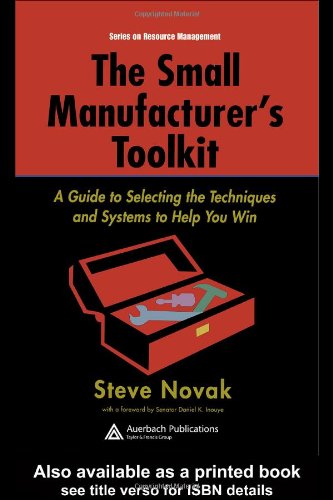موضوعات
آموزش و پرورش
ادبیات و زبان
پزشکی، دندانپزشکی و داروسازی
تاریخ و جغرافیا
داستان و رمان
دیگر
دین و فلسفه
روانشناسی
ریاضیات و آمار
سلامتی، تناسب اندام و رژیم غذایی
شیمی و پلیمر
علوم اجتماعی و حقوق
علوم زیستی و بیوتکنولوژی
فیزیک و نجوم
کامپیوتر و اینترنت
کتابهای کودکان و داستان
کسب و کار و اقتصاد
کشاورزی و دامپزشکی و غذا
معماری
مهندسی و فناوری
هنر و تئاتر
محصولات
The Small Manufacturer's Toolkit: A Guide to Selecting the Techniques and Systems to Help You Win (St. Lucie Press Series on Resou) - PDF
نویسندگان: خلاصه: Lean, Six Sigma, Sales & Operations Planning, Theory of Constraints, ISO 9000, and more. There are many management systems and techniques being promoted today. It is time consuming and expensive to learn all you need to know about them so that you can make an informed decision about which ones might be the best for you to implement. This book describes the fundamental principals behind the systems and provides you with a diagnostic tool that will help you decide which ones are best for you. All the information you will need to prevent costly, and possibly devastating, mistakes by trying to implement a system that is not appropriate for your unique situation, all in one easy to read reference guide. This book is written in an easy to read and comprehend conversational style not normally found in books of this type. Examples are provided that will help you understand the concepts behind each topic that is presented.The Complete Personalize Promise Bible for Women: Every Single Promise in the Bible Personalized Just for You - PDF
نویسندگان: خلاصه: The Bible is filled with over 1,800 promises from God to bless, encourage, and instruct us. Why would God give so many promises? he knew in this world we would need them. But if you don't know what those promises are, you will not have a basis for your faith or a solid foundation to put your trust in. The Complete Personalized Promise Bible for Women takes you through every single promise in the Bible, listed in topical format for easy reference. Each promise is recorded from various Bible translations and includes a personalized, Scripture-based declaration of faith. By studying these promises and praying them back to the Father God, you will establish your faith for those promises to be a part of your life. Let God's Word become so rooted in your spirit that you will not be able to turn from the truth or give up, no matter how difficult your situation is. God has made a way for you to overcome!You Can't Say That!: The Growing Threat to Civil Liberties from Antidiscrimination Laws - PDF
نویسندگان: خلاصه: 10 Insider Secrets to a Winning Job Search offers a complete step-by-step roadmap on how to get the job you want--fast--even in tough times! This book will motivate you, increase your self-confidence, and show you how to sell yourself so companies want to hire you. You'll have an unfair advantage when searching for a job! Todd Bermont shares with you the secrets he has learned to find a job in any economy, secrets that he used to get six job offers his senior year of college, to land three job offers in one week during a recession, and to earn numerous job promotions since. Additionally, having also been a hiring manager, Todd gives you a behind-the-scenes look into the hiring process that will give you another unfair advantage. With this book you'll: * Develop and maintain a winning attitude throughout your job search. * Convince companies to hire you...even when no positions are available.10 Insider Secrets to a Winning Job Search: Everything You Need to Get the Job You Want in 24 Hours - Or Less - PDF
نویسندگان: خلاصه: 10 Insider Secrets to a Winning Job Search offers a complete step-by-step roadmap on how to get the job you want--fast--even in tough times! This book will motivate you, increase your self-confidence, and show you how to sell yourself so companies want to hire you. You'll have an unfair advantage when searching for a job! Todd Bermont shares with you the secrets he has learned to find a job in any economy, secrets that he used to get six job offers his senior year of college, to land three job offers in one week during a recession, and to earn numerous job promotions since. Additionally, having also been a hiring manager, Todd gives you a behind-the-scenes look into the hiring process that will give you another unfair advantage. With this book you'll: * Develop and maintain a winning attitude throughout your job search. * Convince companies to hire you...even when no positions are available.Intermediate College Korean - PDF
نویسندگان: خلاصه: This companion volume to College Korean (California, 1992) enables students to continue their development of Korean language skills and to enrich their understanding of Korea. Because language is a fundamental component of culture, the text incorporates themes relating to Korea's cultural customs and social issues, presented in the form of dialogues, anecdotes, short essays, and poems. Also included are themes tied to the country's physical geography, including major cities, islands, and historical sites. Each lesson consists of a situation dialogue, core vocabulary, idiomatic expressions, grammar, and exercises on reading and listening comprehension. The vocabulary uses adult-level words from the media and professional worlds and ranges from computer terms to martial arts. Unlike other Korean language texts, Intermediate College Korean goes well beyond everyday survival skills and offers students a much wider exposure to both the language and culture of Korea. A reference section includes an index to patterns and grammar notes, a glossary, spelling tips, a list of connectives, and irregular verb charts.Heart of the Artist : A Character-building Guide for You & Your Ministry Team - PDF
نویسندگان: خلاصه: Over 100,000 sold *Great for individuals and teams *Includes provocative discussion questions 'I wish I had your gift!' How do you handle those words as a creative artist? Somewhere between pride and self-abasement lies true humility---just one aspect of the balanced character God wants to instill in you as an actor, a musician, a visual artist, or other creative person involved in ministry. God is interested in your art and your heart. The Heart of the Artist deals head-on with issues every person in an arts ministry faces: *Servanthood Versus Stardom *Excellence Versus Perfectionism *The Spiritual Disciplines of the Artist *The Artist in Community . . . and more The Heart of the Artist will give you a better understanding of yourself and your unique place in the body of Christ. You'll find wisdom and encouragement that can help you survive the challenges and reap the rich joys of a ministry in the creative arts. 'Breathtakingly personal, practical, and poignant.'---Timothy Tien, New York, New York 'I am better for having applied these principles. . . . A must-read for church staff, creative types, growing Christians, human beings.'---Rev. Ginny Allen, Jackson, Mississippi 'Rory Noland pinpoints issues that often arise in the life of the artist, and gives good, biblical solutions. A must-have for Christian artists in any field.'---Tom Hinkle, Tulsa, Oklahoma Rory Noland is director of Heart of the Artist Ministries (www.heartoftheartist.org), an organization dedicated to turning teams of church artists into communities of grace. A composer songwriter, author, and speaker, Rory is a graduate of the Chicago Musical College at Roosevelt University and served for twenty years as music director at Willow Creek Community Church.When You're Not Expecting: An Infertility Survival Guide - PDF
نویسندگان: خلاصه: Surviving the challenges of infertilityOften enduring years of heartache, couples with infertility number over 7.3 million. Enduring the daunting difficulties of treatment is something few women are prepared for. Based on the personal stories of 200 women determined to overcome infertility, this surprisingly upbeat survivors' guide gives the kind of hard-won wisdom essential to making it through the process. Not only does the book detail coping strategies, it also presents tips for strengthening stressed relationships and addresses the unique needs of single women and lesbians.An essential guide for women and couples, friends and family, and health care providers and therapists, this book offers the solace and strength needed to prevail even after years of struggle.Written by a therapist, consultant, and public speaker dedicated to the study of infertility and its emotional impactOther titles by Shapiro: When Part of the Self Is Lost and Infertility and Pregnancy LossFor any woman or couple who feel as if they're facing infertility alone, When You're Not Expecting is a must-have book.http://connieshapiro13.blogspot.com/The Lazy Man's Way to Riches: DYNA PSYC Can Give You Everything in the World You Really Want! - PDF
نویسندگان: خلاصه: In 1973, Joe Karbo wrote and published this unique personal guide revealing the secrets that gained him a net worth in excess of $10 million dollars (a lot of money in 1973). Joe sold his book only through direct response advertising...a book that sold over 3 million copies without ever being available in a bookstore! "The Lazy Man's Way to Riches" is Joe's philosophy on life, and how to live it richly, successfully, joyously and lazily. It is a wonderful step by step marketing guide that will work for any business - so clearly written it has been used as marketing text by companies, colleges, and universities worldwide. It is now a classic in both the Self-Help/Personal Development and the Direct Response Marketing fields. This Rare, Original 1973 Limited Edition direct from Joe Karbo's original Publishing Company is a classic that belongs in everyone's Success library!You're Broke Because You Want to Be: How to Stop Getting By and Start Getting Ahead - Original PDF
نویسندگان: خلاصه: Now in paperback: The New York Times bestselling author and star of A&E’s reality series Big Spender, Larry Winget, cleans up America’s personal finance crisisMore than 40 percent of families today are feeling financial pressure: spending more than they earn, and worrying about retiring and being dependent on the government, family, or charity. Larry Winget knows. He grew up poor, then made and lost a fortune when a business in which he’d invested went bankrupt. But he worked his way back from rock bottom to become a multimillionaire. In You’re Broke Because You Want to Be, Winget expands on the ideas that have made his popular television show Big Spender a hit and offers straightforward talk about coming to grips with your finances, such as: · Feel bad. Have remorse. You need to feel deep emotion to take action. So start crying and take responsibility. · Figure out who you owe and how much you owe. It’ll be a scary number to face, but you need to know where you are and what you have. · “People are stupid, lazy, or they don’t give a damn.” You already know you need to do something; Larry will help you finally do something. · Are you more interested in looking cool and being cute or providing a financially secure future for your family? How you spend your money will tell you that. With a boot-camp regimen that is steeped in personal accountability, Winget cuts through the double-talk contained in most finance books and presents a simple, guided program that is sure to motivate anyone out of their money problems.Steal These Ideas!: Marketing Secrets That Will Make You a Star - PDF
نویسندگان: خلاصه: Working for nearly thirty years with and for leading companies including Citigroup, American Express, Epsilon, Apple, and Fidelity—with notable political and not-for-profit campaigns along the way—Steve Cone has the kind of hard-earned, high-level experience that translates into valuable, tested ideas on what really works—and doesn’t—in marketing.In Steal These Ideas! Cone delivers hundreds of pearls in a sharp, no-nonsense, and witty style on all facets of marketing, branding, and advertising with all the candor and freshness one would expect from a knowledgeable good friend in the business.Illustrated throughout with examples of the good, bad, and ugly in advertising, this is the secret stuff that no one ever teaches. Anyone can now steal these ideas and become a marketing star today.آیا کتاب مورد نظر هنوز بر روی سایت قرار نگرفته است؟ جای نگرانی نیست! کافی است بر روی گزینه سفارش کتاب کلیک کرده و درخواست خود را ثبت کنید. در کمتر از چند ساعت کتاب شما را آماده خواهیم کرد.









